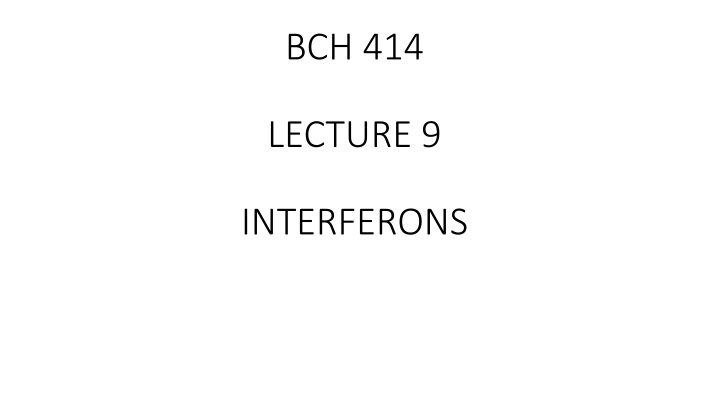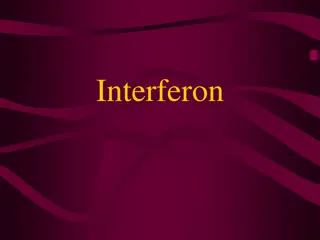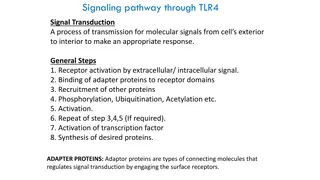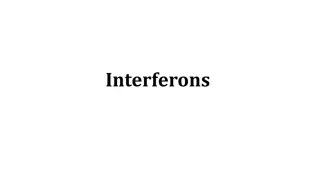BCH 414 LECTURE 9 INTERFERONS
Interferons are vital proteins produced by infected cells to combat viral agents. They stimulate adjacent healthy cells to produce antiviral proteins, inhibiting viral replication. Interferons can also trigger the destruction of infected cells. Learn about the history, functions, and importance of interferons in the immune system's defense against pathogens.
Download Presentation

Please find below an Image/Link to download the presentation.
The content on the website is provided AS IS for your information and personal use only. It may not be sold, licensed, or shared on other websites without obtaining consent from the author.If you encounter any issues during the download, it is possible that the publisher has removed the file from their server.
You are allowed to download the files provided on this website for personal or commercial use, subject to the condition that they are used lawfully. All files are the property of their respective owners.
The content on the website is provided AS IS for your information and personal use only. It may not be sold, licensed, or shared on other websites without obtaining consent from the author.
E N D
Presentation Transcript
BCH 414 LECTURE 9 INTERFERONS
Highlight How does our innate immune system deals with pathogen? How do an infected cell release proteins? What do interferons binds to? Can interferons stimulate cell death of the infested cell. How do IFNs function to inhibit the multiplication of some, but not all, viruses? What strategies are used by viruses to counteract the antiviral actions of IFNs?
Overview of Interferons One way in which our innate immune system deals with infected cells is by using interferons. When a cell is infected by a viral agent or a parasite, it will begin to produce proteins known as interferons. The interferons are released to the outside environment and then travel to adjacent healthy cells. Once bound to the cells, the interferons will stimulate the cells to produce anti-viral proteins that can block viral replication. This means that by the time the infected cell lyses and releases the newly synthesized viral agents to the surroundings, the neighbouring healthy cells will be ready for the attack. In addition, the interferons also call upon specialized leukocytes for the destruction of infected cell. The interferon can even stimulate the self- destruction process of the infected cell, perhaps by lysing the lysosomes found in the cell.
History of Interferons In 1950 s Yasu-Ichi Nagano and Yashuhiko Kojima, Japanese virologist discovered the viral inhibitory factors. In 1957, Alick Issacs and Jean Lindenman reported that influenza virus-infected chick cells produced a secreted factor that mediated the transfer of a virus-resistant state active against both homologous and heterologous viruses. Exposure of the live influenza virus on chick egg chorioallantoic membranes to the heat inactivated form of influenza interfered with the subsequent growth of a live virus on the surface preparation. Hence, name interferon came into action as it interfered with the growth of the live virus. In 1958 Nagano and Kojima set the stage for subsequent studies that led to the elucidation of the IFN system in exquisite detail.
Interferons Interferons are a multigene family of inducible cytokines. They are chemical signaling molecules present in all immune system of vertebrate species and possibly by some invertebrates as well. Interferons are an extraordinary group of protein with important effects on immune system. Their actions affect both innate and adaptive immunity (first line of body s defense against infections). The various forms of interferon are the body s most rapidly produced and important defense against viruses. They are detectable within two hours on exposure to infection. They are host specific but not virus specific. Normal cells do not synthesize interferons until induced to do so. RNAviruses are strong inducers than DNAviruses They possess antiviral activity and named interferon for its ability to interfere with viral proliferation.
Interferons Interferon can also combat bacterial and parasitic infections, inhibit cell division, and promote or impede the differentiation of cells. Interferon is secreted by cells in response to stimulation by a virus or other foreign substance, but it does not directly inhibit the virus s multiplication. Rather, it stimulates the infected cells and those nearby to produce proteins that prevent the virus from replicating within them. Further production of the virus is thereby inhibited and the infection is stemmed. Interferons also have immunoregulatory functions they inhibit B-lymphocyte (B-cell) activation, enhance T-lymphocyte (T-cell) activity, and increase the cellular-destruction capability of natural killer cells. Interferons are highly potent, <50 molecules per cell are sufficient to induce anti-viral state.
Types of Interferons There are classified into 2 basic types of interferons depending Type I interferon also known as leucocyte interferon and are produced by virus infected leucocytes. They are involved in the induction of an increase in expression of both Class I MHC (IFN and IFN ) - The IFN is grouped into IFN l and IFN ll both are produced by leucocytes with the same number of amino acids of about 20 related proteins. - IFN are produced by virus infected fibroblast or epithelial cells and leucocytes or by activated macrophages and dendritic cells. Type II interferon (T-lymphocytes) induces increase expression of Class II MHC (IFN ) molecules and augmentation of NK cell activity.
Type II interferon IFN is produced in response to antigens including viral antigens or mitogen stimulation of lymphocytes. A powerful modulator of the adaptive immune response, biasing T cell help toward TH1 type and inducing the activation of macrophages with subsequent destruction of any intracellular pathogens and differentiation of cytotoxic T cell. Note: An alternative type of interferon is sometimes present which is known as the IFN (type lll) Type III IFN contains three members IFN 1, IFN 2, IFN 3. It up-regulates the expression of the genes controlling viral replication and host cell proliferation.
Functions of interferons Have indirect antiviral properties Restrict the replication and assembly of viral particles Can activate macrophages, neutrophils and natural killer cells Interferons can also activate T cells Enhance the phagocytic properties of macrophages Increase the antigen presenting capacity of antigen presenting cells Have anti-proliferative effect on cell division Increase the expression of MHC class I and class II molecules in various cells
Mechanism of Interferons Interferons are not expressed in normal cells but virus infection of a cell causes interferons to produce and release from the cell in which the cell mostly die as a result of infection. The interferons then bind to target cell and initiate an antiviral state. Both DNA and RNA viruses can induce interferon production but RNA virus tend to induce higher level of interferons. Viruses are target specific, and the DNA or RNA virus binds to specific receptors on a target cell and induce transcription of 20-30 genes ultimately forming mRNA. This induces formation of 20-30 proteins.
Mechanism of Interferons Among these proteins 3 proteins appears to paly important role in induction of antiviral state. One of these protein called 2,5-oligo A synthase results in activation of second protein called ribonuclease which can breakdown mRNA and causes expression of third protein; a protein kinase. The kinase inhibits the initiation step of protein synthesis. These activities of proteins target not only viral protein synthesis but also of host protein synthesis. Activation of these proteins results in death of cell but prevents the progression of virus infection.
Application of Interferon IFN : Treatment of hepatitis B and hepatitis C infections. In cancer therapy Leukemia responds well to IFN in type B cell leukemia known as hairy cell. Treatment of kaposis sarcoma. IFN : In the clinical improvement of Multiple sclerosis (MS). IFN : For treating malignancies that include lymphoma and myeloma. In treating chronic granulomatous disease(CGD). In the treatment of osteopetrosis, a life threatening congenital disease that is characterized by overgrowth of bone
Reviews! Ask your questions regarding the topic!! Believe we achieve our goal in this course!!! Thank you for your cooperation in the course!!!!














![BCH 462- Biotechnology & Genetic engineering [Practical]](/thumb/273367/bch-462-biotechnology-genetic-engineering-practical.jpg)
